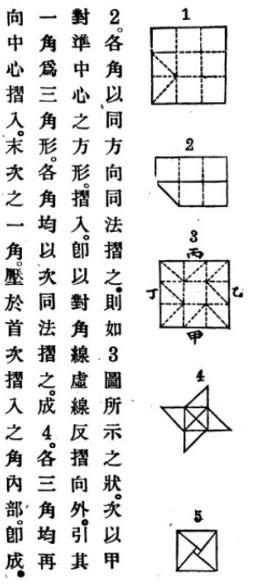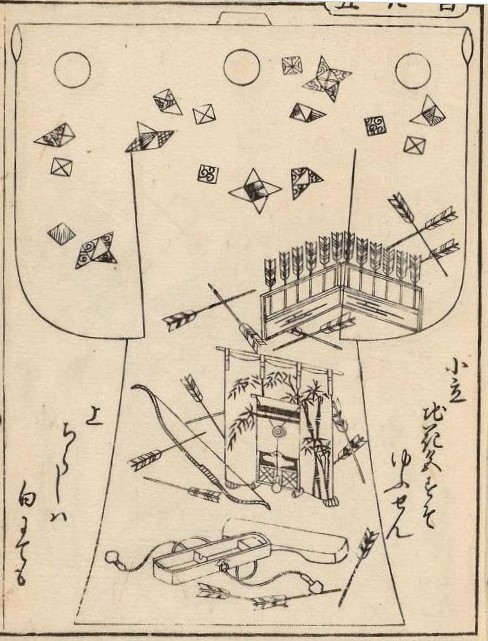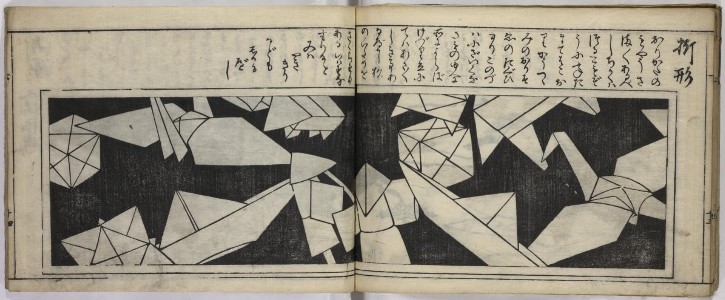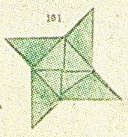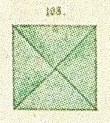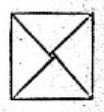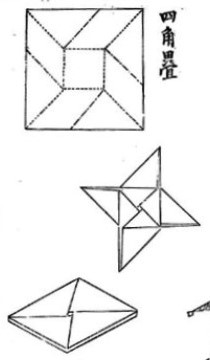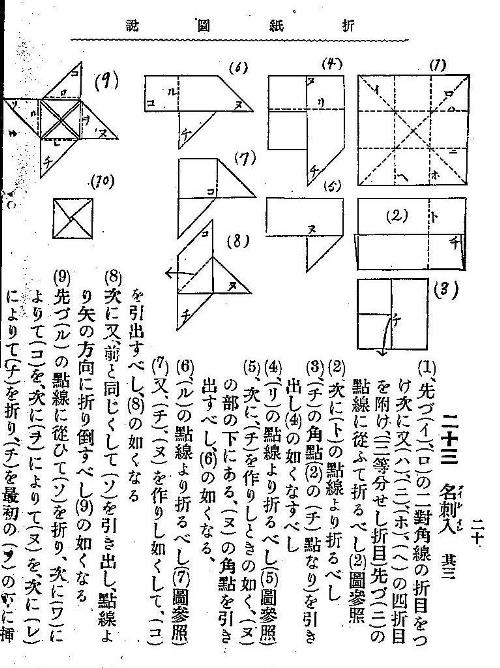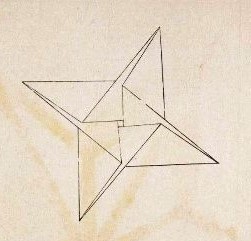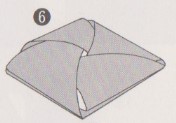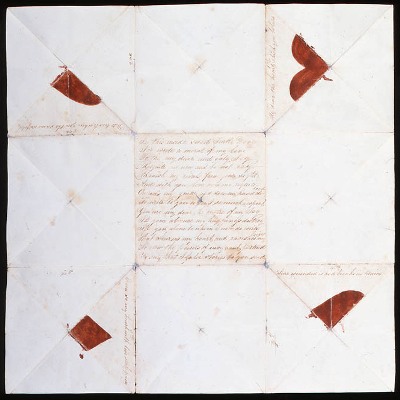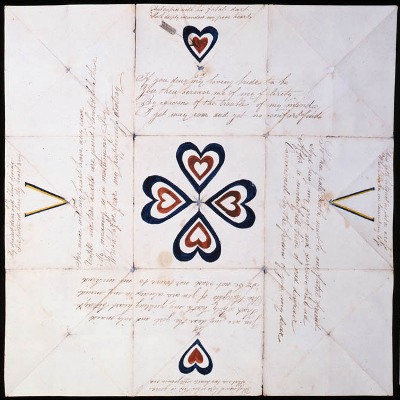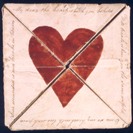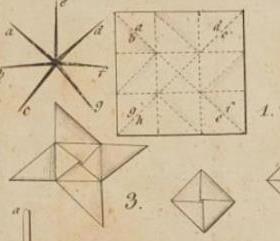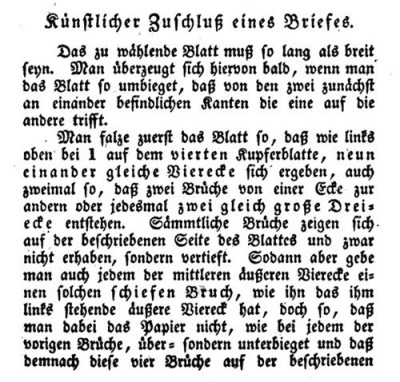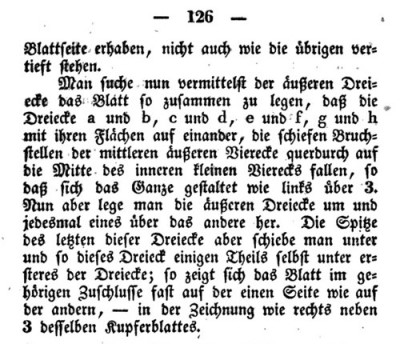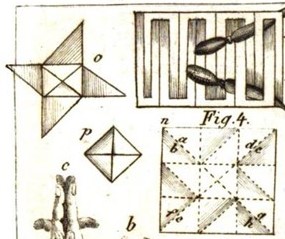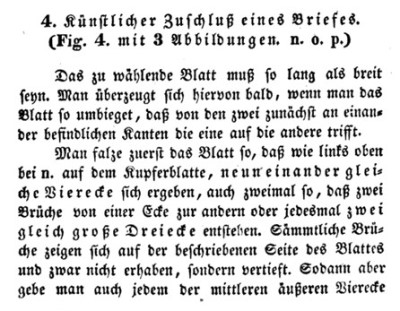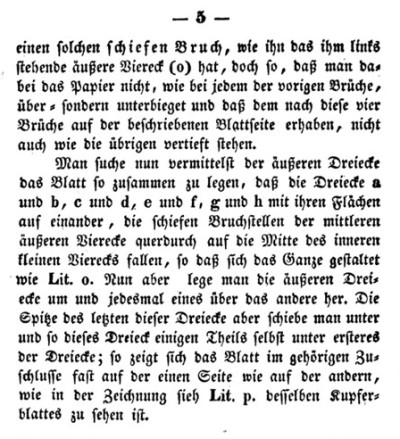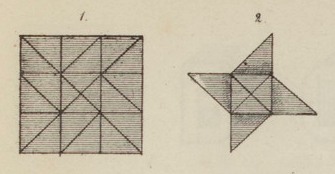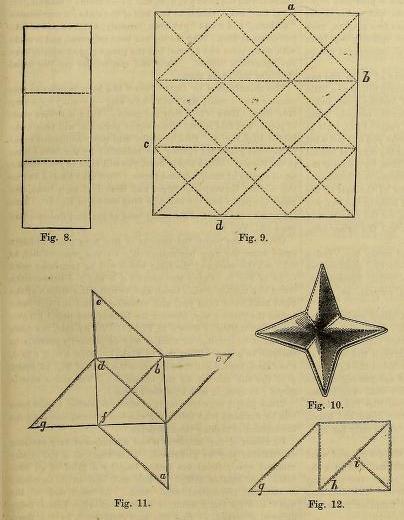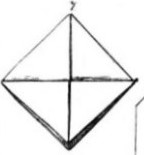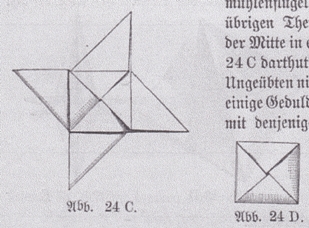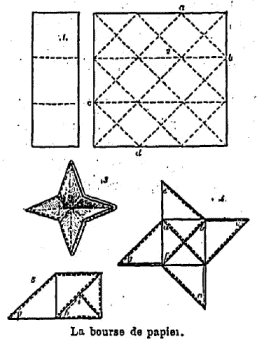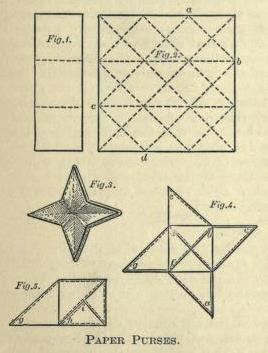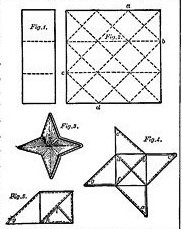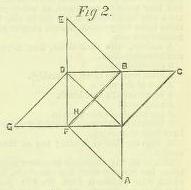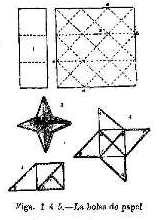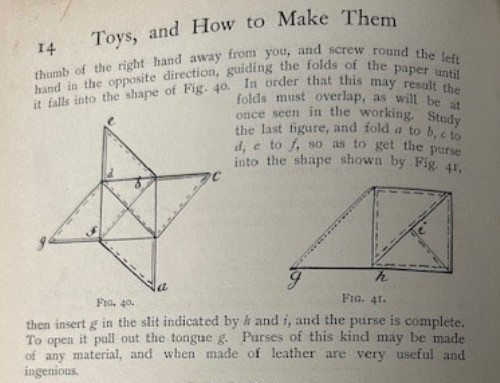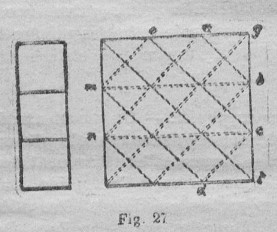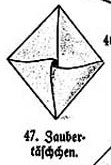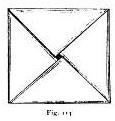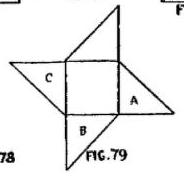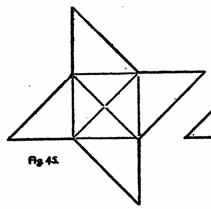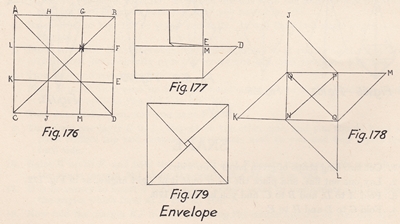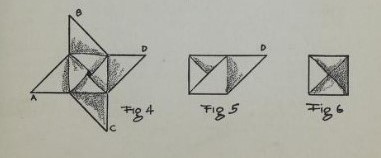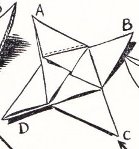| The Public Paperfolding History Project
Last updated 30/4/2024 x |
|||||||
| Puzzle Purse / Pinwheel / Thread Container / Menko | |||||||
This page is being used to collect information about the history of the paperfolding design known in Japan as the Thread Container (originally) or the Menko (later) and in Western Europe and the USA as the Puzzle Purse or, when the arms have not been tucked in, as the Pinwheel. Please contact me if you know any of this information is incorrect or if you have any other important information that should be added. Thank you. This is one of the few designs for which there is early evidence in both the Japanese and the Western paperfolding traditions. ********** In China (and in publications by Chinese authors) 1914 Diagrams for this design, titled 'Camphor Bag', appear in 'Zhe zhi tu shuo' (Illustrated Paperfolding), compiled by Gui Shaolie, which was published by the Commercial Press in Shanghai in Ming guo 3 (1914). It seems to be intended for use as a mothball.
********** In Japan (and in publications by Japanese authors) The design is originally a form of tato, a small folded package which was used to contain items such as threads, hence the name Thread Container. The design has acquired the name 'menko' because these packages can be used to play the Japanese game of the same name in which one player flicks cards or tiles (also known as menko) to try to turn over, and thus win, another player's cards or tiles, which are laid on the floor. For a fuller description of the game see Wikipedia https://en.wikipedia.org/wiki/Menko. Six Thread Containers can be combined together to make the cube known as the Tematebako. ********** 1719 The earliest evidence I am aware of for the existence of this design in Japan comes from a print in 'Hinagata kiku no nae', which is a kosode pattern book. The author of the book is unknown. I do not know whether the conjunction of this design with archery in the pattern is significant or not. It is, I suppose, possible that a thread container could be used to wrap a bow string and keep it dry, but I do not know of any other evidence to confirm that this might be the case.
********** 1734 A cube identified as the 'Tematebako' or 'magic treasure chest appears in 'Ranma Zushiki', a book by Hayato Ohoka published in 1734. This cube should probably be identified as the cube known from later sources which is made by gluing six thread containers together.
********** 1845 There is a note in the 'Kan No Mado', usually dated to 1845, which lists a 'thread container' among those designs which are already well known and which are therefore not included in the ms (in order to spare the writer's brush). ********** 1878 Both the Pinwheel and the Thread Container are pictured in 'Yochien Ombutsu No Zu', a publication of kindergarten material issued by the Tokyo Women's Normal School in 1878.
********** 1904 A drawing of the design, titled (Wrapper for) 'Small Things', appears in 'Shukouka Kyoju Shishin: Maiji Haitou' by Hyojiro Nakagaki, which was published by Kenseikai in Tokyo in 1904.
********** 1905 Diagrams appear in 'Shukouka Kyohon : Liron Jishuu Souga Setsumei' by Kikujiro Kiuchi, Rokushiro Uehara and Hideyoshi Okayama, which was published by Shigebei Takase in Chiba in 1905.
********** 1908 As 'Business Card Holder' in 'Origami zusetsu' (Illustrated Origami) by Sano Shozo, which was published in Tokyo in 1908.
********** 1935 'Origami Moyo, Book One', by Kawarazaki Kodo, which was published by Unsodo in Japan in 1935, contained a print showing an open Thread Container.
********** 1965 The Thread Container also appears in 'The World of Origami' by Isao Honda, which was published in the USA by Japan Publications Trading Company in 1965.
********** In Western Europe and the Americas 1769 The earliest evidence for this design that I can find outside Japan is a liebesbrief (love letter) in the collection of the Free Library of Philadelphia dated to 26th December 1769 (https://libwww.freelibrary.org/digital/item/5835) The date is in the bottom right corner of the illustration below. The crease lines that divide the large square into a grid of nine smaller squares and allow it to be collapsed into a puzzle purse are clearly visible. The practice of decorating puzzle purses as love letters was probably brought to Philadelphia by immigrants from Germany and so, although it is now in Philadelphia, this puzzle purse may be of European origin.
********** c1790 Puzzle purses were also used as valentines. Here is an example in English from the collection of the Postal Museum in the UK dated c1790. The pictures show the front, the back and the fully folded design.
********** 1819 As far as I know formal instructions / diagrams for folding this design first appear, under the title 'Das verfangliche Laschchen' (The insidious flap), 'in 'Leichte Künsteleien zum Vergnügen und zum Nutzen für Kinder und Richtfinder' by Heinrich Rockstroh, which was published in Berlin by Ludwig Wilhelm Wittich in 1819. (Information from Edwin Corrie: 'Two Early Letterfolds' in British Origami 320 of February 2020)
********** The design also appears: 1831 In 'Mechanemata oder der Tausendkünstler' by Dr Heinrich Rockstroh, which was published in 1831, under the heading 'Artful Closure of a Letter'.
********** 1839 In the 5th edition of 'Das Buch der Zauberei' by Johann August Donndorff, which was published in Vienna in 1839.
********** 1863 In 'De Kleine Papierwerkers 1: Wat men van een stukje papier al maken kan: Het vouwen' (The Small Paperwork 1: What one can make from a piece of paper: Folding) by Elise Van Calcar, which was published by K H Schadd in Amsterdam in 1863., where it is called 'Het speldentasche' (the pin badge).
********** 1869 A design called 'Den Strickbeutel' (the knitting-pouch), which is not illustrated, appears in a list of designs in 'Der Kindergarten' by Hermann Goldammer, which was published by Habel in Berlin in 1869. The 1874 edition of 'Der Kindergarten',however, contains an illustration of den Strickbeutel which appears to be a Puzzle Purse) (The translation of Strickbeutel as 'knitting-pouch' comes from Edward Wiebe's 'Paradise of Childhood', also published in 1869 and which is closely based on Goldammer's book. ********** 1873 In 'The Popular Recreator', which was published by Cassell and Co in London in 1873.
********** 1874 A design titled 'Eine Tasche, Eine Strickbeutel' (A Knitting Pouch), which is probably the Puzzle Purse, appears in 'Der Kindergarten' by Hermann Goldammer, which was published by Carl Babel in Berlin in 1874.
********** 1876 In 'Des Kindes Erste Beschaftigungsbuch' by E Barth and W Niederley, which was first published in Bielefeld and Leipzig, and the foreword of which is dated October 1876.
********** 1880 In 'Un million de jeux et de plaisirs' by T de Moulidars, which was first published in 1880 and subsequently republished under the title 'Grande encyclopédie méthodique, universelle, illustrée, des jeux et des divertissements de l'esprit et du corps', under the title 'La Bourse'.
********** 1881 In 'Cassell's Book of Indoor Amusements, Card Games and Fireside Fun', which was published by Cassell and Co in London in 1881.
********** 1887 As 'Paper Purses' in 'The Home Book for Very Little People' by J H Vincent, which was published by Phillips and Hunt in New York in 1887.
********** 1891 In 'Pleasant Work for Busy Fingers' by Maggie Browne, published by Cassell and Company in London in 1891, where it is called 'The Paper Sweet Box'. This book is an English version of 'Des Kindes Erste Beschaftigungsbuch' enhanced by the addition of a few extra designs. ********** In the Boy's Own Paper issue 656 of 8th August 1891, under the title 'How to Fold a Purse out of Paper'.
********** 1895 In Eleenore Heerwart 'Course of Paperfolding', published in 1895, contains a drawing of the finished purse together with a crease pattern. The design is not named in this book. ********** 1896 As 'La Bolsa' in 'Repertorio Completo de Todos los Juegos' by de Luis Marco y Eugenio de Ochoa y Ronna, which was published in Madrid by Bailly-Bailliere e hijos in 1896.
********** 1904 As 'Paper Purses' in The Book of Indoor Games' by J K Benson, which was published by C Arthur Pearson Limited in London in 1904.
********** 1909 As 'Le bourse' in 'Petit Manuel de Travaux d'Amateurs' by H de Graffigny, which was published by Collection A L Guyot in Paris in 1909.
********** 1910 As 'Zaubertäschchen' (magic bag) in Part 2 'Das Flechten' of 'Die Frobelschen Beschaftigungen' by Marie Muller-Wunderlich, which was published by Friedrich Brandstetter in Leipzig in 1910.
********** As 'A Paper Purse' in 'Handicraft in the School', which was issued in four volumes by Gresham Publishing in London in 1910.
********** 1920 In 'Paper Magic' by Will Blyth, which was first published by C Arthur Pearson in London in 1920.
********** 1922 In 'Houdini's Paper Magic', which was published by E P Dutton and Company of New York in 1922, where it is called 'The Japanese Purse'..
********** 1928 In Murray and Rigney's 'Fun With Paperfolding', published in New York in 1928, where it is called the 'Secret Envelope'.
********** 1936 In 'Paper Toy Making' by Margaret Campbell, which was first published by Sir Isaac Pitman and Sons Ltd in London, probably in 1937, although both the Foreword and Preface are dated 1936, which argues that the book was complete at that date, where it is simply called the 'Envelope'.
********** 1939 As 'The Japanese Purse' in 'Fun with Paper' by Joseph Leeming, which was published by Spencer Press Inc in Chicago in 1939.
********** 1956 As 'The Purse' in 'Paper Magic' by Robert Harbin, which was published by Oldbourne in London in 1956. The text says, 'Origin:Japanese'.
********** |
|||||||
